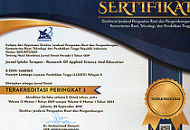POSITIVE DEVIANCE GIZI PADA KELUARGA MISKIN DI DESA BARU, SAROLANGUN JAMBI
Merita Merita(1*), Hesty Hesty(2)
(1) Sekolah Tinggi Ilmu Kesehatan Baiturrahim Jambi
(2) Sekolah Tinggi Ilmu Kesehatan Baiturrahim Jambi
(*) Corresponding Author
Abstract
Objective: The purpose of this study was to analyze the positive deviance of nutrition among poor families in Village’s Baru, Sarolangun, Jambi. Methods: This study used a cross-sectional study design. This research was conducted in April until August, 2016. The sampling technique in this research is total sampling. The samples is all mothers who have children under five (24-60 months) from poor families in Village’s Baru, Sarolangun Jambi as many as 86 mothers. Determination of nutritional status using indicators of Weight for Age, which refers to the standard Kemenkes RI. The data of positive deviance, family and characteristics, taken using a questionnaire tools. The data collected was analyzed by univariate. Results: Univariate analysis showed that the positive deviance of infant feeding practice habits (91,9%), toddler's care (86,0%), toddler's hygiene (69,8%), utilization of health services (89,5%) categorized was good.Â
Keywords: Nutrition, Poor Families, Positive Deviance
Tujuan: Tujuan dari penelitian ini adalah untuk menganalisis positive deviance gizi pada keluarga miskin di Desa Baru, Sarolangun Jambi. Metode: Penelitian ini menggunakan desain cross sectional study. Penenilitan ini telah dilaksanakan pada April sampai Agustus 2016. Teknik penelitian adalah total sampling. Sampel penelitian adalah semua ibu yang memiliki balita (24-60 bulan) berasal dari keluarga miskin di Desa Baru, Kabupaten Sarolangun, Jambi sebanyak 86 ibu. Pengukuran status gizi menggunakan indikator Berat Badan menurut Umur (BB/U) berdasarkan indikator Kemenkes RI. Data positive deviance gizi, karakteristik keluarga menggunakan instrumen kuesioner. Data yang telah terkumpul dilakukan analisis secara univariat. Hasil: Hasil analisis univariat menunjukkan bahwa positive deviance gizi kebiasaan pemberian makan (91,9%), pengasuhan balita (86,0%), kebersihan balita (69,8%), pemanfaatan fasilitas kesehatan (89,5%) tergolong baik.
Kata Kunci: Gizi, Keluarga Miskin, Positive Deviance
Keywords
Full Text:
References
Amugsi, D.A. et al., 2014. Influence of childcare practices on nutritional status of Ghanaian children: a regression analysis of the Ghana Demographic and Health Surveys. BMJ open, 4(11), p.e005340.
Ajao KO, Ojofeitimi EO, Adebayo AA, Fatusi AO, Afolabi OT. 2010. Influence of family size, household food security status, and child care practices on the nutritional status of under-five children in Ile-Ife, Nigeria. Afr J Reprod Health 14(4):123-132.
Anas, U.K. (2013). Pengaruh Karakteristik Keluarga dan Pola Asuh terhadap Status Gizi Balita pada Ibu Menikah Dini di Wilayah Kerja Puskesmas Keude Geureubak Kecamatan Banda Alam Kabupaten Aceh Timur. Skripsi. Fakultas Ilmu Kesehatan Universitas Sumatera Utara. Medan.
Basit A, Nair S, Chakraborthy KB, Darshan BB, Kamath A. 2012. Risk factors for under-nutrition among children aged one to five years in Udupi taluk of Karnataka, India: a case control study. Australasian Medical Journal 5(3):163-167.
Bolles, K., Speraw, C., Berggren, G., & Lafontant, J. G. (2002). Ti foyer (hearth) community-based nutrition activities informed by the positive deviance approach in Leogane, Haiti: A programmatic description. Food and Nutrition Bulletin, 23(4), 11–17.
Cesare MD, Sabates R, Keith M. Lewin. 2013. A double prevention: How maternal education can affect maternal mental health, child health and child cognitive development. Longitudinal and Life Course Studies 4(3).
[CORE] Child Survival Collaborations and Resources Group. (2003). Positive Deviance & Health, Suatu Pendekatan Perubahan Perilaku dan Pos Gizi. Diterjemahkan oleh PCI-Indonesia. Jakarta
Dearden, K. A., Quan, L. N., Do, M., Marsh, D. R., Pachon, H., Schroeder, D. G., & Lang, T. T. (2002). Work outside the home is the primary barrier to exclusive breastfeeding in rural Viet Nam: Insights from mothers who exclusively breastfed and worked. Food and Nutrition Bulletin, 23(4), 101–108.
Dewi, S., 2010. Hubungan antara Pola Pemanfaatan Pelayanan Kesehatan dan Morbiditas dengan Status Gizi Balita di Kelurahan Gemolong Kecamatan Gemolong Kabupatena Sragen. Universitas Muhammadiyah Surakarta.
Frost M, Forste R. & Haas D. (2005). Maternal education and child nutritional status in Bolivia: Finding the links. Soc Sci Med, 60(2):395-407.
Hidayat, T.S. & Jahari, A.B., 2012. Perilaku Pemanfaatan Posyandu Hubungannya Dengan Status Gizi Dan Morbiditas Balita. Buletin Penelitian Kesehatan, 40(1 Mar), pp.1–10.
Jahari. (2000). Penyimpangan Positif Masalah KEP di Jakarta Utara DKI Jakarta dan di Pedesaan Kabupaten Bogor-Jawa Barat dan Lombok Timur –NTB. Jakarta: LIPI dan UNICEF
[Kemenkes RI] Kementrian Kesehatan Republik Indonesia. 2013. Riset Kesehatan Dasar 2013. Jakarta: Kemenkes RI.
Kurniasih D, Hilmansyah H, Astuti MP, Imam S. (20100. Sehat dan BugarBerkat Gizi Seimbang. Jakarta: Gramedia.
Khomsan, A., 2014. Akses Pangan, Higiene, Sanitasi Lingkungan, Dan Strategi Koping Rumah Tangga Di Daerah Kumuh. RISALAH KEBIJAKAN PERTANIAN DAN LINGKUNGAN: Rumusan Kajian Strategis Bidang Pertanian dan Lingkungan, 1(2), pp.59–66.
Leavy, B. (2011). Leading adaptive change by harnessing the power of positive deviance. Strategy and Leadership 39(2):18–27
Lubis, R. (2008). Hubungan Pola Asuh Ibu dengan Status Gizi Anak Balita di Wilayah Kerja Puskesmas Pantai Cermin Kecamatan Tanjung Pura Kabupaten Langkat Tahun 2008. Skripsi. USU
Lutter et al. (2011). Undernutrition, Poor Feeding Practices, and Low Coverage of Key Nutrition Intervention. Pediatric 128 (6):e1418–e1427
Mackintosh, U., Marsh, D. R., & Schroeder, D. G. (2002). Sustained positive deviant child care practices and their effects on child growth in Viet Nam. Food & Nutrition Bulletin 23(4): 16–25
Madanijah S. 2003. Model pendidikan „GI-PSI-SEHAT‟ bagi ibu serta dampaknya terhadap perilaku ibu, lingkungan pembelajaran, konsumsi pangan dan status gizi anak usia dini [disertasi]. Bogor (ID): Program Pascasarjana, Institut Pertanian Bogor.
Mashal et al. 2008. Factors associated with the health and nutritional status of children under 5 years of age in Afghanistan: family behaviour related to women and past experience of war-related hardships. BMC Public Health 8:301
Merita. (2013). Keberlanjutan Dampak Penyuluhan Gizi Terhadap Perilaku Gizi Ibu Dan Kualitas Pelayanan Posyandu. Tesis. Bogor: IPB
Mosquera PA, Hernandez J, Vega R, Martinez J, Labonte R, Sanders D, and Sebastian MS. 2012. Primary health care contribution to improve health outcomes in Bogota-Colombia: a longitudinal ecological analysis. BMC Family Practice 13:84
Nursalam. (2005). Asuhan keperawatan bayi dan anak (untuk perawat dan bidan). Edisi 1. Jakarta: Salemba Medika
Ogunba BO. (2006). Maternal behavioural feeding practices and under-five nutrition: Implication for child development and care. Journal of Applied Sciences Research 2(12):1132-1136
Parvanta, C. F., Thomas, K. K., & Zaman, K. S. 2007. Changing nutrition behavior in Bangladesh: Successful adaptation of new theories and anthropological methods. Ecology of Food and Nutrition, 46(3-4): 221-244
Pascale, R. T., Sternin, J., & Sternin, M. (2010). The Power of Positive Deviance:How Unlikely Innovators Solve the World’s Toughest Problems. Boston: Harvard Business Press.
Pryer, J. A., Rogers, S., & Rahman, A. (2004). The epidemiology of good nutritional status among children from a population with a high prevalence of malnutrition. Public Health Nutrition, 7(2): 311–317
Rapar, V.L. et al., 2014. Hubungan pola asuh ibu dengan status gizi balita di wilayah kerja puskesmas ranotana weru kecamatan wanea kota manado. , pp.1–7.
Saaka, M., Larbi, A. & Hoeschle-zeledon, I., 2015. Factors Contributing To Positive Nutritional Deviance in the Growth of Children. Jacobs Journal of Food and Nutrition, 2(2), pp.1–12.
Rayhan I, Khan SH. (2006). Factor causing malnutrition among under five children in Bangladesh. Pakistan Journal of Nutrition 5(6):558-562
Reyes, Hortensia. 2004. The family as determinant of stunting in children living in conditions of extreme poverty:a case control study. BMC Public Health 4(57).
Setijowati, N., Wirawan, N.N., Apriyanto, D. (2012). Perbedaan Pola Asuh Makan pada Berbagai Tingkatan Posyandu terhadap Tingkat Konsumsi Energi dan protein Balita di Kecamatan Moyo Hulu Kabupaten Sumbawa Nusa Tenggara Barat. Tesis. Fakultas Kedokteran Universitas Brawijaya. Malang.
Soetjiningsih. (2012). ASI, Petunjuk Untuk Tenaga Kesehatan. EGC. Jakarta.
Sripaipan, T., Schroeder, D. G., Marsh, D. R., Pachón, H., Dearden, K. A., Ha, T. T., & Lang, T. T. (2002). Effect of an integrated nutrition program on child morbidity due to respiratory infection and diarrhea in northern Viet Nam. Food and Nutrition Bulletin, 23(4), 70–77.
The Positive Deviance Initiative. (2010). Basic Field Guide to the Positive Deviance Approach. Tufts University
Turnip, OS., Aritonang, EY., Siregar, M., 2014. Hubungan Pendapatan, Penyakit Infeksi dan Pengetahuan Ibu dengan Kejadian Gizi Kurang pada Balita di Wilayah Puskesmas Glugur Barat Tahun 2014. Jurnal Kesehatan Masyarakat, 3(2), pp.25–37.
World Bank. (2006). Repositioning Nutrition as Central to Development, A strategy for Large-Scale Action. Washington DC (US): World Bank
Yusniah. (2008).Hubungan Pola Asuh orang Tua dengan prestasi Belajar Siswa MTS AL-FALAH Jakarta Timur.
Yulia, C., Sunarti, E., Roosita, K. (2010). Pola Asuh Makan dan Kesehatan anak Balita pada Keluarga Wanita Pemetik Teh di PTPN VIII Pengalengan. Info Pangan dan Gizi, 19(2).
Refbacks
- There are currently no refbacks.
Copyright (c) 2019 Jurnal Ipteks Terapan

This work is licensed under a Creative Commons Attribution 4.0 International License.
Online ISSN : 2460-5611 | Print ISSN : 1979-9292
Publish by LLDIKTI Wilayah X (Sumatera Barat, Riau, Jambi dan Kepulauan Riau)
Jl. Khatib Sulaiman No 1 Kota Padang. Kode Pos 25144. Telp 0751-7056737. Fax 0751-7056737. Website:http://www.kopertis10.or.id
This work is licensed under a Creative Commons Attribution 4.0 International License.








.png)






_(1).jpg)



